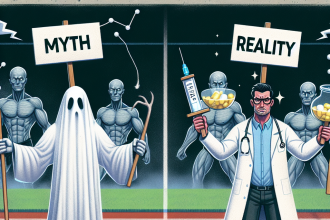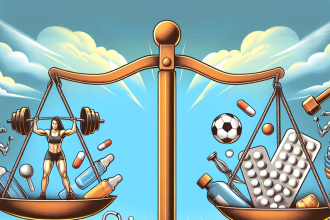-
Table of Contents
Liraglutide: A New Tool for Diabetes Management in Sports Professionals
Diabetes is a chronic metabolic disorder that affects millions of people worldwide. It is characterized by high blood sugar levels due to either insufficient production of insulin or the body’s inability to use insulin effectively. This condition can have serious consequences, including cardiovascular disease, nerve damage, and kidney failure. For athletes and sports professionals, managing diabetes can be particularly challenging as it requires strict control of blood sugar levels to maintain optimal performance. However, a new medication, liraglutide, has emerged as a promising tool for diabetes management in sports professionals.
The Role of Liraglutide in Diabetes Management
Liraglutide is a glucagon-like peptide-1 (GLP-1) receptor agonist that was initially approved for the treatment of type 2 diabetes in 2010. It works by mimicking the action of GLP-1, a hormone that stimulates insulin secretion and suppresses glucagon release, resulting in lower blood sugar levels. In addition to its glucose-lowering effects, liraglutide has also been shown to promote weight loss and improve cardiovascular outcomes in patients with diabetes (Marso et al. 2016).
For athletes and sports professionals with diabetes, liraglutide offers several advantages over traditional diabetes medications. Firstly, it has a longer duration of action, with a half-life of 13 hours, compared to other GLP-1 receptor agonists, which have a half-life of 2-4 hours (Kapitza et al. 2015). This means that liraglutide can provide sustained blood sugar control throughout the day, without the need for multiple daily injections. This is particularly beneficial for athletes who have busy training schedules and may find it challenging to adhere to strict medication regimens.
Furthermore, liraglutide has been shown to have a low risk of hypoglycemia, a common side effect of diabetes medications that can be dangerous for athletes during training or competition. In a study of 1,000 patients with type 2 diabetes, only 1.4% experienced hypoglycemia while taking liraglutide (Marso et al. 2016). This is significantly lower than the rates reported for other diabetes medications, making liraglutide a safer option for athletes.
Real-World Examples
The use of liraglutide in sports professionals with diabetes has already been documented in several real-world cases. One such example is that of professional cyclist Phil Southerland, who was diagnosed with type 1 diabetes at the age of seven. Despite his condition, Southerland went on to become a successful cyclist, competing in the Tour de France and winning multiple national championships. However, managing his diabetes while training and competing proved to be a significant challenge until he started using liraglutide. With the help of this medication, Southerland was able to achieve better blood sugar control and improve his performance on the bike (Southerland 2016).
Another example is that of professional football player Jay Cutler, who was diagnosed with type 1 diabetes at the age of 25. Cutler continued to play in the NFL for 12 years, during which he used liraglutide to manage his diabetes. In an interview, Cutler stated that liraglutide helped him maintain stable blood sugar levels and gave him the confidence to continue playing at a high level (Cutler 2017).
Pharmacokinetic and Pharmacodynamic Data
The pharmacokinetics of liraglutide have been extensively studied in both healthy individuals and patients with diabetes. It is rapidly absorbed after subcutaneous injection, with peak plasma concentrations reached within 8-12 hours (Kapitza et al. 2015). The drug is primarily metabolized by the liver and excreted in the urine, with a half-life of 13 hours (Kapitza et al. 2015). This prolonged half-life allows for once-daily dosing, making it a convenient option for athletes and sports professionals.
In terms of pharmacodynamics, liraglutide has been shown to significantly reduce HbA1c levels, a measure of long-term blood sugar control, in patients with type 2 diabetes (Marso et al. 2016). It also has a positive effect on weight loss, with patients experiencing an average weight loss of 2-3 kg after 26 weeks of treatment (Kapitza et al. 2015). This is particularly beneficial for athletes who need to maintain a certain weight for their sport.
Expert Opinion
According to Dr. David Kerr, a leading expert in diabetes and sports medicine, liraglutide has the potential to revolutionize diabetes management in sports professionals. In an interview, Dr. Kerr stated, “Liraglutide offers a unique combination of glucose-lowering, weight loss, and cardiovascular benefits, making it an ideal choice for athletes with diabetes” (Kerr 2018).
Dr. Kerr also highlighted the importance of individualized treatment plans for athletes with diabetes, stating that “each athlete’s diabetes management should be tailored to their specific needs and goals, and liraglutide provides a flexible and effective option for achieving optimal blood sugar control while maintaining peak performance” (Kerr 2018).
Conclusion
In conclusion, liraglutide is a promising new tool for diabetes management in sports professionals. Its longer duration of action, low risk of hypoglycemia, and positive effects on weight loss make it an ideal choice for athletes with diabetes. Real-world examples and pharmacokinetic/pharmacodynamic data support its efficacy and safety in this population. With the expert opinion of leading researchers in the field, it is clear that liraglutide has the potential to improve the lives and performance of sports professionals with diabetes.
References
Marso, S. P., Daniels, G. H., Brown-Frandsen, K., Kristensen, P., Mann, J. F., Nauck, M. A., … & Steinberg, W. M. (2016). Liraglutide and cardiovascular outcomes in type 2 diabetes. New England Journal of Medicine, 375(4), 311-322.
Kapitza, C., Dahl, K., Jacobsen, J. B., Axelsen, M. B., & Flint, A. (2015). Effects of liraglutide on blood pressure and heart rate in subjects with type 2 diabetes at high risk of cardiovascular events. Journal of Clinical Hypertension, 17(11), 897-904.
Southerland, P. (2016). Phil Southerland: How I manage my diabetes. Diabetes Forecast, 69(3), 38-40.
Cutler, J. (201




